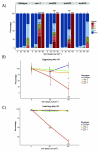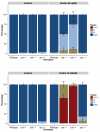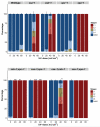A C. elegans homolog of the Cockayne syndrome complementation group A gene
- PMID: 25453470
- PMCID: PMC4255241
- DOI: 10.1016/j.dnarep.2014.09.011
A C. elegans homolog of the Cockayne syndrome complementation group A gene
Abstract
Cockayne syndrome (CS) is a debilitating and complex disorder that results from inherited mutations in the CS complementation genes A and B, CSA and CSB. The links between the molecular functions of the CS genes and the complex pathophysiology of CS are as of yet poorly understood and are the subject of intense debate. While mouse models reflect the complexity of CS, studies on simpler genetic models might shed new light on the consequences of CS mutations. Here we describe a functional homolog of the human CSA gene in Caenorhabditis elegans. Similar to its human counterpart, mutations in the nematode csa-1 gene lead to developmental growth defects as a consequence of DNA lesions.
Keywords: C. elegans; Cockayne syndrome; Nucleotide excision repair.
Copyright © 2014 Elsevier B.V. All rights reserved.
Figures




References
-
- Schumacher B, Garinis GA, Hoeijmakers JHJ. Age to survive: DNA damage and aging. Trends Genet. 2008;24:77–85. doi:10.1016/j.tig.2007.11.004. - PubMed
-
- Cleaver JE, Lam ET, Revet I. Disorders of nucleotide excision repair: the genetic and molecular basis of heterogeneity. Nat Rev Genet. 2009;10:756–768. doi:10.1038/nrg2663. - PubMed
-
- Hanawalt PC, Spivak G. Transcription-coupled DNA repair: two decades of progress and surprises. Nat. Rev. Mol. Cell Biol. 2008;9:958–970. doi:10.1038/nrm2549. - PubMed
-
- Laugel V, Dalloz C, Durand M, Sauvanaud F, Kristensen U, Vincent MC, et al. Mutation update for the CSB/ERCC6 and CSA/ERCC8 genes involved in Cockayne syndrome. Hum Mutat. 2010;31:113–126. doi:10.1002/humu.21154. - PubMed
Publication types
MeSH terms
Substances
Grants and funding
LinkOut - more resources
Full Text Sources
Other Literature Sources
Research Materials

